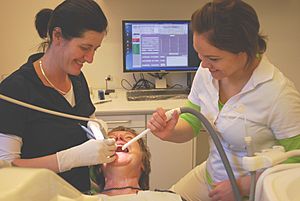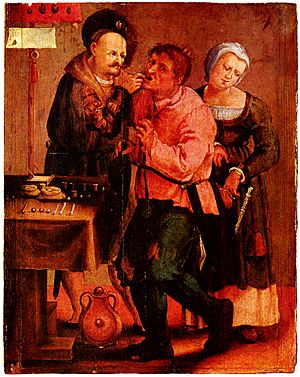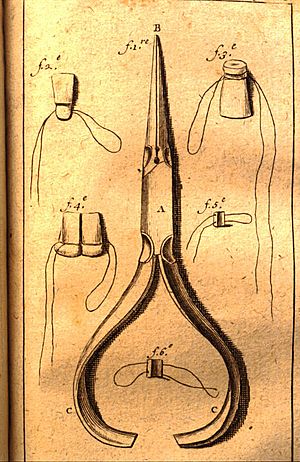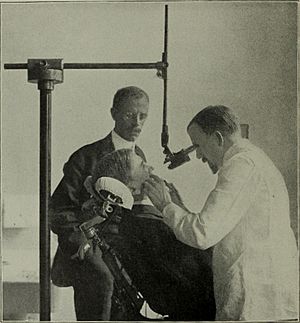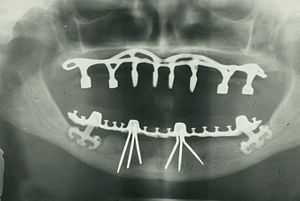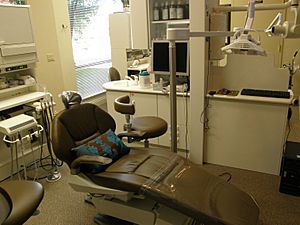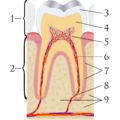Dentistry facts for kids
Dentistry is a special kind of healthcare focused on your teeth, gums, and mouth. A dentist is the main doctor who helps you keep your mouth healthy. They find out what's wrong, fix problems, and help you prevent new ones.
Dentists often work with a team:
- A dental hygienist helps you keep your teeth super clean and teaches you how to brush and floss well.
- A dental assistant helps the dentist during check-ups and treatments.
- Some dentists are dental surgeons. They do surgery to fix bigger or more serious problems in your mouth, like removing wisdom teeth.
- Other dentists are orthodontists. They help move your teeth into the right place using braces or other tools to give you a straight smile.
Dental surgeons and orthodontists are called "specialists" because they have extra training in a specific area of dentistry.
Dental Specialties
Dentistry has many different areas, each focusing on a special part of your mouth or a specific type of care:
- Dental public health: This area is about keeping many people's teeth healthy. It's like planning dental care for a whole community or town.
- Endodontics: These dentists treat problems inside your teeth, especially when the soft middle part (called the pulp) gets sick or injured. They often do root canals.
- Oral pathology: This is about studying and finding out what's wrong with diseases in your mouth and jaw.
- Oral and Maxillofacial Radiology: These specialists use X-rays and other scans to look closely at your teeth, jaw, and face to find problems.
- Oral and Maxillofacial Surgery: These surgeons perform operations like taking out teeth, placing dental implants, or fixing problems with your jaw and face.
- Orthodontics: This is all about straightening teeth and fixing bites to give you a healthy, beautiful smile.
- Periodontics: These dentists specialize in treating gum disease and keeping your gums healthy.
- Pediatric dentistry: This is dentistry just for kids! These dentists are experts at making children feel comfortable and taking care of their growing teeth.
- Prosthodontics: These dentists specialize in replacing missing teeth with things like dentures, bridges, or implants. Some even learn to replace missing parts of the face, like ears or noses.
History of Dentistry
Long, long ago, before people started farming (about 10,000 years ago), tooth decay was not very common. But once farming began, people ate more sugary foods, and cavities (tooth decay) became a bigger problem.
The oldest known dental work was found in Italy, on a tooth that was partly cleaned with flint tools about 14,000 years ago! Even older, some studies suggest that Neanderthals might have used simple dental tools 130,000 years ago.
Around 7000 BC, in the Indus Valley civilization, people were already practicing dentistry. They used special bow drills to fix tooth problems. It seems their methods were quite good for the time. The oldest dental filling ever found was made of beeswax in Slovenia, about 6,500 years ago.
Ancient texts from Sumer (a very old civilization) believed that a "tooth worm" caused cavities. This idea was also found in ancient India, Egypt, Japan, and China. Even as late as the 1300s, some surgeons still thought worms caused tooth decay!
Ancient Egyptians had recipes for treating toothaches and loose teeth, written on papyrus scrolls. One scroll from about 1700 BC even talks about fixing broken jaws. The Code of Hammurabi (a set of laws from 1800 BC) mentioned pulling teeth as a punishment. Some ancient Egyptian and Greco-Roman remains show early attempts at fake teeth, though these might have been added after death for looks.
Greek thinkers like Hippocrates and Aristotle wrote about teeth, how they grow, and how to treat decay and gum disease. They even talked about using forceps to pull teeth and wires to hold loose teeth or broken jaws in place. The Etruscans, an ancient Italian people, might have used the first dental bridges as early as 700 BC. In ancient Egypt, a person named Hesi-Re is known as the first "dentist."
Roman writer Cornelius Celsus wrote a lot about mouth diseases and dental treatments, including pain relievers. The first dental fillings made of a mix of metals were written about in China in 659 AD and appeared in Germany in 1528.
For a long time, dentistry wasn't a separate job. In the Middle Ages and up to the 1800s, Barbers or general doctors often pulled teeth to stop pain or infection. Tools for pulling teeth have been around for centuries. In the 1300s, a tool called the "dental pelican" was used, which looked like a pelican's beak. Later, the "dental key" was used, and finally, modern forceps came along in the 1900s.
The first book completely about dentistry was published in 1530. The first dental textbook in English, called "Operator for the Teeth," came out in 1685.
In the United Kingdom, dentists didn't need a formal qualification until 1859. By 1921, only trained professionals were allowed to practice dentistry.
Modern Dentistry
Modern dentistry really started to grow between 1650 and 1800. A French surgeon named Pierre Fauchard is often called the "father of modern dentistry." Even with simple tools, Fauchard was very skilled. He often changed tools from watch makers, jewelers, and even barbers to use in dentistry.
Fauchard was the first to use dental fillings to treat cavities. He believed that acids from sugar caused tooth decay. He also thought that serious tooth decay could lead to problems in the gums.
Fauchard also pioneered dental prosthesis, which means making fake teeth. He found ways to replace missing teeth using carved ivory or bone. He also introduced dental braces, which were first made of gold wires. He noticed that teeth would move and straighten if guided by these wires. He used waxed linen or silk threads to hold the braces in place. His most important contribution was his book, "The Surgeon Dentist," published in 1728. This book explained how teeth work, how to build fake teeth, and different ways to fix and restore teeth. It helped make dentistry a separate field from general surgery.
After Fauchard, dentistry grew quickly. Two important books were written by British surgeon John Hunter in the 1770s. Hunter worked with a dentist named James Spence and started thinking about transplanting teeth from one person to another. He realized that a fresh tooth that matched in size would have the best chance of success. These ideas are still used today for organ transplants. Hunter tried some of these operations, and even though the transplanted teeth didn't fully connect, one patient had three teeth that lasted six years! This was amazing for that time.
In the 1800s, dentistry changed a lot and became a proper profession instead of just a trade. Governments started regulating it. In the UK, the Dentist Act was passed in 1878, and the British Dental Association was formed in 1879.
Images for kids
-
An oral surgeon and dental assistant removing a wisdom tooth
-
Early dental chair in Pioneer West Museum in Shamrock, Texas
-
A modern dental clinic in Lappeenranta, Finland
See also
 In Spanish: Odontología para niños
In Spanish: Odontología para niños


